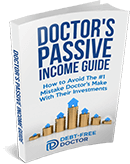506b vs 506c Explained: A Guide for Investors
If you’ve looked into investing in private real estate deals, you’ve probably come across the terms 506b and 506c. They sound complicated, but they’re just two different types of investment offerings under Regulation D of the Securities Act.
These rules come from the U.S. Securities and Exchange Commission and allow smaller companies and fund managers to legally raise money from investors like you, without going through the full registration requirements of a public offering.
As a passive investor, understanding the difference between 506b and 506c is crucial. It affects how you discover investment opportunities, whether or not you need to prove your income or net worth, and what kind of communication and disclosures to expect from sponsors.
In short, it helps you make informed, compliant, and potentially profitable decisions.
Rather watch instead? Check out this video:
What Is Regulation D?
Regulation D was created by the Securities and Exchange Commission to give smaller businesses, private real estate syndicators, and venture funds a way to raise capital without completing a full public registration.
Safe Harbor
It offers what’s known as a “safe harbor” under the Securities Act, which means issuers have clear guidelines to follow to remain compliant. This safe harbor enables private securities offerings—also known as private placements of securities—without the expensive and time-consuming filing requirements typical of a public offering.
This is particularly valuable for syndicators, fund managers, and real estate operators who are offering securities in the form of equity shares in a property or fund. Regulation D provides a framework where they can raise capital from a broader pool of potential investors, depending on the structure they choose: 506b or 506c.
Related: What Is Real Estate Syndication? A Beginner’s Guide
Understanding 506b Offerings
Quiet Deals for Known Investors
A 506b offering is typically private and low-profile. Sponsors are not allowed to use general solicitation or advertising. They cannot promote these deals publicly through social media, podcasts, websites, or mass emails.
Establishing a relationship
Instead, they can only offer the investment to individuals with whom they have a pre-existing substantive relationship (like for my Passive Investors Circle group).
This relationship is more than just an email sign-up. It involves knowing the investor’s financial background, goals, and risk tolerance, enough to establish a reasonable belief that the investment is suitable.
The idea is that you’re not learning about the deal for the first time from an ad; you’re hearing about it from someone you’ve built trust with over time.
Who Can Invest?
Under 506b, issuers can accept an unlimited number of accredited investors and up to 35 non-accredited investors, as long as those non-accredited investors are provided with detailed disclosure documents, including audited financial statements and comprehensive explanations of risk factors.
Accredited investors under U.S. securities regulations are individuals who meet certain thresholds, such as:
-
An annual income of $200,000 individually or $300,000 jointly with a spouse, or
-
A net worth exceeding $1 million (not including their primary residence)
For 506b offerings, investors may self-certify their accredited status by simply checking a box. However, it’s still wise to understand your investor status and consult with a financial advisor if needed.
Understanding 506c Offerings
Public Deals With Extra Compliance
506c offerings flip the script. These allow general solicitation and advertising, making them visible on social media, investor platforms, podcasts, and email campaigns. They’re ideal for sponsors who want to cast a wider net and tap into a larger investor base.
But there’s a catch: only accredited investors can participate in 506c deals, and they must go through a verification process. The SEC requires sponsors to take “reasonable steps” to verify each investor’s accreditation status.
What Counts as Reasonable Steps?
Reasonable steps to verify accreditation may include:
-
Reviewing two years of tax returns to confirm annual income
-
Looking at bank or brokerage statements to validate net worth
-
Obtaining a letter from a CPA, attorney, or registered broker-dealer stating you meet the requirements
This verification requirement exists because the use of general solicitation creates a risk of uninformed or unsuitable investors participating. By enforcing documented checks, the SEC aims to keep 506c offerings secure and fair.
For the investor, this can feel like extra paperwork, but it ensures that only those who can financially bear the risks are getting involved.
Related: Accredited Investor Letter: How To Prove Your Status
Don’t Miss Any Updates. Each week I’ll send you advice on how to reach financial independence with passive income from real estate.
Sign up for my newsletterKey Differences That Matter to Investors
Deal Visibility
506b: Private. You’ll only hear about these if you have a pre-existing relationship with the sponsor.
506c: Public. You can find these deals online, on social media, or through podcasts and platforms.
Investor Eligibility
506b: Open to both accredited investors and up to 35 non-accredited investors (with full disclosures).
506c: Accredited investors only, with documentation required.
Disclosure Requirements
506b: If non-accredited investors are involved, sponsors must provide detailed background information and financial statements. This helps protect less experienced investors.
506c: Disclosure is lighter because only accredited investors are involved, but the emphasis is placed on verifying investor status.
Benefits and Considerations for Passive Investors
If you’re new to real estate syndications or investing through a self-directed IRA, 506b deals can offer a more personalized experience, often shared within a trusted circle or investor club. But you’ll need to be proactive and build relationships early.
If you’re an accredited investor who wants access to a wider range of deals, 506c offerings can be more plentiful and easier to find. However, you must be ready to provide documentation and navigate a more formal verification process.
In both cases, these are private offerings of securities, not traded on major stock exchanges. That means they’re less liquid, have longer hold periods, and come with unique risk factors you’ll need to evaluate.
Always review the offering documents closely, understand the sponsor’s track record, and ask about business matters like the investment strategy, property management plan, and projected cash flow. A quality sponsor will be transparent about all of this upfront.
Final Thoughts
Knowing the difference between 506b and 506c offerings gives you a major edge as a passive investor. These aren’t just legal codes—they directly impact how you invest, who you can invest with, and how much documentation you’ll need to provide.
Both options are designed to make it easier for fund managers and smaller companies to raise capital, while still protecting investors under the umbrella of U.S. securities regulations. Regulation D of the Securities Act continues to be one of the most useful tools for creating access to high-quality private placements of securities.
Whether you’re investing in a real estate syndication, a venture fund, or another private securities offering, always understand the requirements of the rule, your rights as an investor, and the due diligence steps you should take before moving forward.
By learning these details now, you’re setting yourself up to find better deals, avoid mistakes, and build long-term wealth more strategically.
Join the Passive Investors Circle


